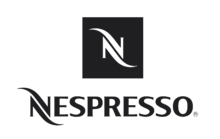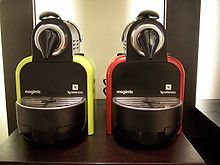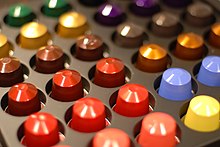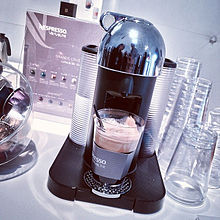Nespresso

Nespresso is the brand name of Nestlé Nespresso S.A., an operating unit of the Nestlé Group, based in Lausanne, Switzerland.[1] Nespresso machines brew espresso from coffee capsules, a type of pre-apportioned single-use container of ground coffee and flavorings. The company sells its system of machines and capsules worldwide, as well as the VertuoLine system in North America.
History
In 1976, Eric Favre, an employee of Nestlé, invented, patented and introduced the Nespresso system[2][3] to the business market in Switzerland without significant success. In 1988, due to the efforts of Jean-Paul Gaillard — a business man, the inventor of «Le Club» community —,[4] the product became a market success. In 1990, the firm signed a contract with Turmix, which started to sell Nespresso machines in Switzerland. Thereafter, other contracts were signed with Krups, Magimix, Alessi, Philips, Siemens and De'Longhi.
The first patent application for Nespresso's process of brewing espresso from capsules containing ground coffee was filed in 1996.[citation needed]
The Nespresso Company manufactures both machines and the capsules they use, and makes most of its money from the capsules. Nespresso machines and their capsules can be purchased in Nespresso stores, by mail-order, or many other consumer appliance stores. The company fights off producers of cheaper compatible capsules in court.
Machines

Nespresso sells a number of different machines. The machines carry the brand names of well known kitchen equipment manufacturers such as Krups, Magimix, Miele, Siemens, and DeLonghi, but are mostly manufactured by Eugster/Frismag, a Swiss company that is one of the world's largest coffee machine producers. While based in Amriswil, Switzerland, Eugster/Frismag mostly manufactures in China under the Krups, Turmix, DeLonghi and Magimix brands. Krups and Magimix stores often display models "Made in Switzerland" (noted on the bottom of the machine) but others machines come from China. The Lattissima models are manufactured by DeLonghi. Eugster/Frismag is little known to the public because the company is strictly an original equipment manufacturer (OEM) and does not sell under its own brand.[5] In 2000, Nespresso began distributing machines bearing the "Nespresso" brand.
In August 2011 Australian brand Kogan announced they were developing the "Ez-press",[6] a coffee machine compatible with Nespresso pods.[7]
Capsules




Nespresso capsules are sold exclusively by Nespresso and are significantly more expensive than an equivalent quantity of "loose" ground coffee. The cost per serving is up to three times higher than that of alternative brewing methods.[8] Because of the hermetically sealed capsule, however, the coffee aroma does not degrade with time like coffee in a pack that has been opened. Nespresso sells 21 different coffee "Grand Cru" arabica and robusta capsules. Two Limited Edition Grand Crus are released every year as well as a new set of Variations, flavored espresso capsules.
Each capsule contains 5–6 grams of ground coffee and makes one cup of coffee. Depending on the length of the pour, the capsule can produce a 40 ml espresso shot, or a 110 ml lungo (long) pour. The capsule body and perforated top are both made of aluminium, and are mostly not recycled. To assuage concerns on potential aluminium health effects, most of the capsule interior is lined with food-grade lacquer.[9]
Australian company PodCafe[10] released a 'one size fits all' refillable capsule[11] in 2012. Their refillable pod fits most Nespresso compatible machines, and also allows users to brew tea and hot chocolate.[11]
The Dutch company Douwe Egberts has launched a coffee capsule compatible with Nespresso machines in Europe and the US.[12] Unlike the Nespresso capsules, the "L'OR EspressO" capsules are made out of plastic instead of aluminium, and unlike the Nespresso capsule these are pre-perforated rather than perforated in the top when inserted in the machine. The capsules therefore come individually packaged, each in their own airtight bag, rather than being themselves airtight. Douwe Egberts recently added new varieties of these coffees; there are now fourteen.
Italian company Caffè Vergnano has also launched capsules compatible with Nespresso machines, called Èspresso,[13] and was attacked by Nestlé Nespresso S.A.[14] notably because Vergnano capsules, unlike Nespresso ones, can be found in supermarkets and small shops.
Pure Origin
- Dulsão do Brasil (intensity:4)
- Indriya from India (intensity:10)
- Rosabaya de Colombia (intensity:6)
- Bukeela ka Ethiopia (intensity:3) - Introduced on January 21, 2014
Espresso range
- Kazaar (intensity:12)
- Dharkan (intensity:11)
- Ristretto (intensity:10)
- Arpeggio (intensity:9)
- Roma (intensity:8)
- Decaffeinato Intenso (intensity:7)
- Livanto (intensity:6)
- Capriccio (intensity:5)
- Volluto (intensity:4)
- Cosi (intensity:3)
- Decaffeinato (intensity:2)
Lungo range
- Fortissio Lungo (intensity:8) (re-introduced in June 2014 as "Fortissio Lungo Renovation", with an increase in intensity from 7 to 8, as compared with the previous Fortissio Lungo)
- Vivalto Lungo (intensity:4)
- Finezzo Lungo (intensity:3) (phased out in January 2013, replaced by Linizio[15])
- Decaffeinato Lungo (intensity:3)
- Linizio Lungo (intensity:4) – January 2013
Variations range
- Vanilio (intensity:6) - June 2013
- Ciocattino (intensity:6) - June 2013
- Caramelito (intensity:6) - June 2013
Limited editions
Each year Nespresso markets 'limited edition' grand cru. These appear twice a year, in the spring and in the Autumn. The latter was formerly branded as Special Club.
Limited edition range
- Ensibuko (intensity:7 or 8) - Fall 2006
- Oâ (intensity:?) - Spring 2007
- Jalayatra (intensity:8) - Fall 2007
- Jinogalpa (intensity:6) - Fall 2008
- Goroka (intensity:6) - Spring 2008
- Tanzaru (intensity:4) - Spring 2010
- Onirio (intensity:5) - Spring 2011
- Dhjana (intensity:8) - Fall 2011
- NaOra (intensity:5) - Spring 2012 [16]
- Crealto (intensity:8) - Fall 2012 [17]
- Napoli (intensity:11) & Trieste (intensity:9) - Spring 2013[18]
- Cauca (intensity:6) & Santander (intensity:7) - Spring 2014 (collectively referred to as the "Columbian Terroirs") [19]
- Cubanía (intensity:13) - Fall 2014 [20]
Special reserve
Around Christmas 2012, Nespresso launched its first Special Reserve Limited Edition coffee, the Hawaii Kona Special Reserve 2012 (intensity:5).[21] This was based on Kona coffee beans which is one of the most expensive coffees in the world. They sold for A$30 in Australia.
In October 2014, Nespresso launched Maragogype Special Reserve (intensity:6).[22] They sold for €12 in Europe, £10 in the UK and US$20 in the United States (for a sleeve of 10).
Variations
Each year towards Christmas time Nespresso also releases high end capsules known as 'variations'. Variations are flavoured coffees marketed as a treat for their club members.
- 2006 – Apricot, Chestnut Cream and Gingerbread
- 2007 – Almond, Cardamon and Chocolate Orange
- 2008 – Caramel, Mandarin and Crystallized Ginger
- 2009 – Crème de marrons (Chestnut Cream), Apricot and Pain d’Épice (Gingerbread)[23]
- 2010 – Vanilla, Caramel and Almond[24]
- 2011 – Vanilla Blossom, Cherry and Dark Chocolate[25]
- 2012 – Hazelnut, Coconut, and Macademia[26]
- 2013 – Cioccorosso OR Masala Chai OR Liminto. (Different from countries, vote by people.)
VertuoLine system


In February 2014, Nespresso launched a new Vertuoline system of machines and capsules in the United States and Canada to appeal to the demand by North Americans in these countries for larger cups of coffee. The system produces both 230-millilitre (8.1 imp fl oz; 7.8 US fl oz) cups of coffee and smaller 40-millilitre (1.4 imp fl oz; 1.4 US fl oz) espressos, both with the crema that characterizes espresso coffees and the original line of Nespresso coffees. Nespresso simultaneously introduced eight coffee blends and four espresso blends in specially-designed VertuoLine capsules. The VertuoLine capsules cannot be used in the original line of Nespresso machines (now branded "OriginalLine" in North America). Nespresso sells both OriginalLine and VertuoLine machines and capsules in the United States and Canada, targeting different market segments with the two systems.[27][28][29]
The VertuoLine capsules are as follows:[30]
- Coffee
- Stormio (intensity: 8)
- Odacio (intensity: 7)
- Melozio (intensity: 6)
- Elvazio (intensity: 4)
- Hazelino (intensity: 6)
- Vanizio (intensity: 6)
- Decaffeinato (intensity: 6)
- Half Caffeinato (intensity: 6)
- Espresso
- Diavolitto (intensity: 11)
- Altissio (intensity: 9)
- Voltesso (intensity: 4)
- Decaffeinato Intenso (intensity: 7)
The VertuoLine system uses two technologies not found in the OriginalLine. First, the system uses "centrifusion" (a term created by Nespresso, being a portmanteau of centrifugal force and infusion), whereby it spins the capsule around in the machine at up to 7,000 rpms to blend the ground coffee and hot water. Second, each capsule has a barcode embedded on the rim, and the barcode laser scanning system reads 5 different parameters: cup size (coffee or espresso), temperature, rotational speed, flow rate and time the water is in contact with the ground coffee.[31] Some critics claim that the VertuoLine technology, particularly the use of bar codes, is an attempt by Nestlé to create a new proprietary Nespresso system which excludes compatible capsules from other companies.[32]
The VertuoLine system is intended to expand Nespresso's product line to offer coffee closer to the American style of filtered coffee, and thus expand Nespresso's market share in North America. In the United States, Nespresso had only a 3% share of the single-serve coffee market in 2013 (compared with 72% for Green Mountain’s Keurig system), while in Canada Nespresso had 4 to 5% of the single-serve market in 2013 (compared to approximately 53% for Keurig and 40% for Tassimo).[27][28] In comparison, Nestlé had 70% of the single-serve market in Europe in 2013.[33]
At the time of the introduction of the VertuoLine system in 2014, there were no plans to launch the system in markets outside Canada and the United States.[34]
Process

Nespresso's hermetically sealed capsules are made of aluminium foil.[35] Depending on the Nespresso machine being used, the flat top of the capsule is pierced when inserted into the machine and the compartment lever is lowered. Some machines make a single large hole, and others make a number of smaller holes. When the machine is activated it pumps hot water under high pressure into injector holes poked into the narrow end of the capsule upon insertion. This causes the flat bottom of the capsule to bow out, as this is made of thinner foil than the rest of the capsule. The base of the capsule holder (on which the capsule sits) has a number of raised squares which cause the foil to rupture at these points. The brewed coffee exits the capsule through these rupture holes and flows through a funnel nozzle into the coffee cup. As in pressure cookers, a safety pressure release valve inside the brewing chamber prevents an explosion from occurring if the normal coffee exhaust path becomes blocked.
The spent capsule must finally be removed from the holder; on some machines this is automated.
Marketing
Social media, such as Facebook, has been used to promote the product in the form of an interactive Facebook page and celebrities, such as George Clooney and John Malkovich, have been used to market the product. The brand's current slogan is What else?. The brand Nespresso is the subject of continued promotional campaigns around the world. Promotions include bonus coffee capsules sold with the machine. TV commercials also feature Penelope Cruz, including a longer promotional video on Nespresso's site and YouTube with Cruz and Jimmy Kimmel.
Market
Packaged portions of espresso coffee like those from Nespresso has become one of the fastest growing segments of the coffee market, accounting for 20 to 40 percent of the value of ground coffee sales in the European coffee market which totals USD 17 billion.
In August 2010, it was reported that Nespresso sales have been growing at an average of 30 percent per year over the past 10 years and more than 20 billion capsules have been sold since 2000 at a current selling price equivalent to about USD 0.43 to USD 0.62 per capsule.[36]
Nespresso reported annual sales of CHF 3 billion in 2011, growing by 20% during the fiscal year.[37]
Criticism
Cost
Nespresso actively discourages customers from purchasing coffee capsules from other sources. As a result, choice of flavours is limited and there is limited competitive downward pressure on capsule prices. Nespresso seeks to position the brand as an exclusive luxury good. The price of capsules in 2014 ranged from US$0.65 to US$0.70 each. There is a minimum order quantity of 50 capsules, and standard shipping for 50 capsules is US$6.95, raising the total cost per capsule to US$0.79 to US$0.84. (Shipping is free for orders of 200 capsules or more.)[38] Smaller quantities, typically 20 capsules minimum, can be bought on eBay for about US$1.00 each, including shipping. For comparison to buying coffee by weight, 167-200 5–6 gram capsules contain one kilogram of coffee (76-91 contain one pound). At 2014 prices the per-weight cost is US$108–140/kilogram (US$49–63/pound). In March 2011, the Swiss discount supermarket, Denner, won a court battle with Nestlé over the sale of Nespresso compatible capsules. The plastic capsules are approximately half the retail price of the Nespresso capsules.[39]
Business model
The concept (machine, capsule, service) is subject to 1,700 patents[36] which protect Nespresso's ownership of the concept until the patents expire.[40][41] This contrasts with some other prepackaged coffee preparation systems. This has led to comparisons of Nespresso with printer manufacturers that tried to hinder the sale of generic ink cartridges, to achieve a vendor lock-in effect.[36]
Nespresso's patents began to expire in 2012,[42] gradually allowing competitors to offer capsules and machines compatible with the Nespresso system. Nestlé is working on ways to prevent competitors from doing this.[36]
Jean-Paul Gaillard, a former CEO at Nespresso has started a rival firm, Ethical Coffee Company SA (ECC), to make compatible biodegradable capsules for the Nespresso machine.[43]
Other competitors include a Swiss start-up, Nexpod, which offers Nespresso-compatible empty capsules which can be filled with the coffee (or tea) by the buyer, CapsuleCup from Hong Kong that provide compatible capsules in bulk and a South African company based in Cape Town which sells Nespresso-compatible capsules under the brand name Café-Caps. Cafe Caps specializes in private label production. Caffè Negrini is sold in over 800 shops in Austria. In the UK, Dualit and Cafepod have both launched generic products. In the United States HiLine Coffee Company launched a website on the 4th of July selling Nespresso compatible capsules with the theme Independence from Nespresso.[44] The Berlin based start-up Gourmesso also offers Nespresso compatible capsules, launching a website in Germany in early 2013 and expanding to other European countries later that year. Gourmesso USA was launched early in 2014.[45]
In March 2014 Indulge Beverages Pvt. Ltd. also launched Nespresso compatible capsules for the Indian Market under the brand name Bonhomia. They introduced a new frontier by also launching Tea capsules compatible with Nespresso machines. Bonhomia is focused on Coffees' and Teas' with an Indian provenance. [46]
In mid-July 2010, Sara Lee, which in France makes coffee under the "Maison de Café" brand, launched L'OR EspressO which uses a plastic capsule that fits both Sara Lee's own espresso machines and the Nespresso system. By August 2010, according to Sara Lee, more than 30 million capsules of L'Or had been sold. Nestlé has sued Sara Lee, accusing the latter of contravening its patents.[36][47] In December 2010, Sara Lee announced that they would start selling their capsules in the US under the Douwe Egberts name,[48] and since mid-2011, Sara Lee has expanded sales of its capsules into other countries, such as Spain where they are sold under the "Marcilla" brand.
Ecological impact
Unless the capsule is recycled, each cup of Nespresso coffee produces aluminium waste, the main material of the capsule. There is 1g of aluminium in one capsule (including the cover) compared to about 13g for a soft drink can. Recycling aluminium uses down to 5% of the energy needed to produce aluminium from ore.[49] To begin with, Nestlé did not implement any recycling programs outside of a few parts of Switzerland.[49] This led to a large per-cup waste generation, which was criticised by some user groups.[50] More countries now have recycling facilities[citation needed]. France and Switzerland are some of Nespresso's biggest buyers so the recycling facilities are more accessible in these countries. In the UK, recycling was rolled out starting in London, Bristol and Bath and now covers all of the mainland. When fresh capsules are delivered by courier (a CO2-intensive process), spent ones are collected in bags provided for the purpose. Used capsules can be also taken to any Nespresso Boutique for recycling. A recycling program has also been introduced in The Netherlands, where consumers have the option to return their used capsules to a limited selection of stores or hand them over to postal services. In the USA, Canada, Australia and New Zealand, consumers can drop off used capsules at Nespresso boutiques for recycling. In Ireland when new capsules are delivered the used capsules can be collected by the courier for recycling. There is, however, no financial incentive anywhere for users to do so.
In recent years some third-party products, such as the Outpresso device, have also emerged that ease the removal of coffee grounds from expended capsules, allowing the aluminum to then be recycled through standard municipal recycling programs.[citation needed]
A minority of capsules are recycled: Nestlé itself states a current rate of 50% in Switzerland and Germany, but only 2% in France.[8] The proportion of recycled aluminium in the capsules is not exactly known, but is estimated to be less than 30%.[51] The company has launched a program called "écolaboration" to try to remedy the problem.
In addition to the recycling programme discussed above, Nespresso states 'ecolaboration' includes a AAA sustainability programme, focused on helping farmers who grow and supply Nespresso coffee. Nespresso claims it does this by teaching farmers best business and growing practices. The company claims participating farmers are not obliged to sell to Nespresso, although the company says many choose to as Nespresso claims to offer a fair price for the coffee and help in all aspects of the farmers' business.[52]
Unlike the regular capsules, Nespresso Pro capsules cannot be recycled because they are made of a mixture of plastic and aluminium. Since the layers of material are sealed to each other, the Pro capsule can only be burned. The refillable capsules from rivals Nexpod and PodCafe are obviously much more environment-friendly. This has led the World Wide Fund for Nature and other environmental agencies to state that "the most reasonable solution is still the purchase of bulk coffee".[51]
See also
- Dolce Gusto
- Delta Cafés
- Gimoka Espresso Italia
- Lavazza
- Flavia
- Handpresso
- Espresso
- Keurig
- Senseo
- Tassimo
- Caffitaly (Caffita)
- Saeco
References
- ^ Our Company, Nestlé Nespresso SA
- ^ Societé (in French), CH: Monodor
- ^ History, Monodor
- ^ Jean-Paul Gaillard (in French), CH: Nouvo
- ^ "Eugster Frismag: Die Perle vom Bodensee". Bilanz (in German). 26 January 2005. Retrieved 5 April 2010.
- ^ http://www.kogan.com.au/shop/ez-press-coffee-machine-nespresso-compatible/
- ^ http://www.cnet.com.au/kogan-waves-budget-wand-at-nespresso-coffee-339320556.htm
- ^ a b Que Choisir, December 2009, p. 57
- ^ http://www.nespresso.com/#/fr/en/coffee_nespresso/nespresso_faq
- ^ PodCafe, AU
- ^ a b Refillable capsules for Nespresso coffee machines, AU: PodCafe
- ^ L'OR EspressO capsules
- ^ "The new compatible capsules by Caffè Vergnano". Retrieved 11 February 2014.
- ^ ""Guerra" delle capsule da caffè Vergnano batte Nespresso". La Stampa. Retrieved 11 February 2014.
- ^ http://www.nespresso.com/ultimate-coffee-creations/INT/en/expertise
- ^ http://www.nespresso.com/naora/
- ^ http://www.nespresso.com/crealto/US_en/index.html
- ^ http://www.nespresso.com/trieste-napoli/
- ^ http://www.nespresso.com/ncp/colombian-terroirs/UK_en
- ^ http://www.nespresso.com/cubania
- ^ http://www.nestle-nespresso.com/newsandfeatures/nespresso-premieres-rare-and-exclusive-limited-edition-hawaii-kona-special-reserve-2012
- ^ http://www.nestle-nespresso.com/newsandfeatures/special-reserve-maragogype-grand-cru-2014,-an-exclusive-coffee-experience-for-connoisseurs
- ^ http://www.simpleespressocoffee.com/2010/01/nespresso-variations-2009-espresso-capsules-review
- ^ http://www.singleserveespresso.com/archives/2010/11/nespresso_variations_2010_-_va.php
- ^ http://au.lifestyle.yahoo.com/marie-claire/competitions/offers/article/-/11319874/agenda-december/
- ^ http://www.nespresso.com/ultimate-coffee-creations/US/en/variations#/home
- ^ a b "Nestle Supersizes Nespresso Machine for U.S. Coffee Drinkers". swissinfo. 19 February 2014. Archived from the original on 4 March 2014. Retrieved 4 March 2014.
- ^ a b Shaw, Hollie (19 February 2014). "Nestlé's Nespresso launching brewing machine to take on Tassimo and Keurig systems". National Post. Archived from the original on 4 March 2014. Retrieved 4 March 2014.
- ^ "Our goal is to create a new premium coffee segment in North America". Nespresso. Archived from the original on 4 November 2014. Retrieved 4 November 2014.
- ^ "Vertuoline". Nespresso. Archived from the original on 4 March 2014. Retrieved 4 March 2014.
- ^ Miller, Matthew (26 April 2014). "Nespresso VertuoLine: Bar codes, lasers, and Centrifusion provide an amazing cup of coffee". ZDNet. Archived from the original on 28 April 2014. Retrieved 28 April 2014.
- ^ Sorensen, Chris (11 March 2014). "As patents expire, companies are desperate to reclaim their monopoly on your pricey morning brew". Maclean's. Archived from the original on 4 November 2014. Retrieved 4 November 2014.
- ^ "Will Nestle's Nespresso VertuoLine Cause Problems for Green Mountain's Keurig 2.0?". The Motley Fool. 2 March 2014. Archived from the original on 4 March 2014. Retrieved 4 March 2014.
- ^ Bouckley, Ben (19 February 2014). "Nespresso believes 'vital innovation' will boost brand's $300m US sales". BeverageDaily.com. Archived from the original on 11 March 2014. Retrieved 11 March 2014.
- ^ La capsule de café Nespresso
- ^ a b c d e Alderman, Liz (21 August 2010). "Nespresso and Rivals Vie for Dominance in Coffee War". The New York Times.
- ^ Nestlé Annual Report 2011
- ^ http://www.nespresso.com/us/en/Order-Capsules/original
- ^ Mulier, Tom (4 March 2011). "Denner to Resume Nespresso-Compatible Capsule Sales After Ruling". Bloomberg.
- ^ "Nespresso : un leader obligé de jouer serré", L'Expansion (in French)
- ^ Nespresso : le café en mode Asp (in French), Wouarf, 16 August 2005
{{citation}}: Unknown parameter|trans_title=ignored (|trans-title=suggested) (help) - ^ Letessier, Ivan (10 April 2009). "Nespresso a toujours du grain à moudre" (in French). FR: Le Figaro. Retrieved 2 December 2009.
{{cite web}}: Unknown parameter|trans_title=ignored (|trans-title=suggested) (help) - ^ "Fire Up Another 4 Billion Cups". Portfolio.com. 31 March 2010. Retrieved 5 January 2011.
- ^ http://www.HiLineCoffee.com
- ^ "Gourmesso USA".
- ^ http://www.bonhomiaworld.com/.
{{cite web}}: Missing or empty|title=(help) - ^ "Nestlé takes action over Nespresso capsules". Switzerland: World Radio. 15 June 2010. Retrieved 16 June 2010.
- ^ "Sara Lee May Sell Nespresso Compatible Capsules in the US under the Douwe Egberts Name". Single Serve Espresso. 16 December 2010. Retrieved 5 January 2011.
- ^ a b The 100%recyclable capsule: Nespresso website, 13 May 2007. In English. Retrieved 2007-05-13.
- ^ Site Name
- ^ a b Template:PDF, Freedom, Nicole della Pietra, Wednesday, 14 February 2007 (the site of Jean-Luc Pasquier).
- ^ ecolaboration Program"
